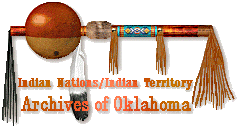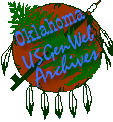Wagoner County, Oklahoma
"Links to web sites that are not part of the US Gen Web Project are provided for
your convenience and do not imply any endorsement of the web sites or their
contents by The USGenWeb
Project."
The following
is an excerpt from the book, Wagoner People, edited by Liz McMahan & Kenneth
Peters.
"Congress passed an act enabling Oklahoma and
Indian Territories to prepare for admission to the Union as a single state. In
January 1907 an election was held and Wagoner was named the county seat of the
new Wagoner County. Porter and Coweta also had vied to have the county seat in
their cities.
By 1905, Wagoner had its third railroad going through the
city. The Missouri, Oklahoma and Gulf ran from Henryetta to Joplin, Mo. A
couple of years later, there were 14 passenger trains a day serving the town's
5,000 residents and the rural area."
*******************************************************************************
The
present site of Wagoner, Oklahoma is located near the intersections of Oklahoma
state highway 51, which runs east and west, and Oklahoma state highway 69, which
runs north and south. Highway 51 runs roughly along the old East Shawnee Trail
and Highway 69 runs roughly along the Texas Road which was a cattle trail moving
cattle from Texas to the railheads in Kansas.
During the civil war,
Stand Waite a confederate general, spied a regiment of black union soldiers
cutting hay on the prairie. Stand Waite observed these soldiers from the top of
Blue Mound Hill, located approximately one and one-half miles west of present
day Wagoner. The next morning before the sun rose, the Union soldiers were
slaughtered. Few soldiers survived. The Union soldiers were trapped by a creek
to their east. Most of these soldiers died in or around the creek. It is
recorded in Civil War history as the Hay-Camp expedition. It is considered to
be the last confederate victory of the civil war because the battle was fought
after the signing of the treaty between Generals Lee and Grant, thus ending the
civil war in 1865. The battle was fought just north of Wagoner along the
military road that linked Ft. Gibson to Kansas. The military road later became
the Texas road. The name of the creek is currently named Soldier
Creek.
In 1871, the Missouri-Kansas and Texas Railroad (MKT) built a
railway from Kansas to Gibson Station, Indian Territory. Gibson Station is
located on present day Highway 16, north of Okay. Present day Gibson Station is
a ghost town and no longer has a post office or stores. About 1883 the KATY
railroad was also running from Kansas to Muskogee. Henry Samuel "Bigfoot"
Wagoner, who was employed with the KATY, decided that a switch was needed to
load cattle and lumber between Gibson Station and Flat Rock. When the switch
was completed, KATY roadmaster, Perry, telegraphed the company that "Wagoner's
switch is ready." Also in 1883, the Kansas and Arkansas Valley Railroad made an
announcement that it would put tracks through this area. Wagoner's switch would
now become a crossroads in railway services.
Wagoner's first "permanent"
residents were William H. and Sallie H. McAnnally on June 05, 1887. William had
been an MKT employee who had previously worked at Wagoner's switch. The family
first slept in a borrowed tent until they moved into the KATY section house.
McAnnally later quit his job with the railroad, and he built a wooden structure
that the railway employees called "The Cottonwood Hotel."
By February
25, 1888, the town's request for a post office was granted and William W. Teague
was the city's first postmaster. There were many enterprises that came to
Wagoner during that time because many people saw the possibility of the Indian
Territory being sold for private ownership.
On September 14, 1891 Bill
Doolin came to Wagoner and had his photograph taken by a local photographer.
The next day he and the members of his gang robbed a train at Leliaetta which
was north of Wagoner. Wagoner's early days consisted of gambling halls
complete with liquor and rowdiness. This was Indian Territory with the closest
judge being at Ft. Smith, Arkansas approximately 200 miles to the
east.
By 1894, Wagoner had several mercantile stores, two drug stores, a
cotton gin, two blacksmith shops, a livery stable, four hotels, a newspaper and
the Cumberland Presbyterian Church. So, on December 03, 1895, a petition was
filed in the federal court at Muskogee to make Wagoner a city. In 1896, Judge
Springer granted the petition and Wagoner became the first town in Indian
Territory to incorporate.
In 1895, Ed Reed, the son of Belle Starr was
appointed as a deputy US Marshall to the Wagoner area. Judge Parker of Ft.
Smith, Arkansas made the appointment after releasing Ed from a prison sentence
that he served two years of before coming to Wagoner. On October 25, 1895, Ed
Reed shot and killed the Crittenden brothers, Dick and Zeke, who were former US
Marshalls in this area as well. Dick and Zeke were reportedly drinking heavily
and shooting up the town when Reed shot the brothers. Reed was tried for the
killings and was released from any wrong doing. Ed Reed was shot and killed a
few years later in Claremore, Indian Territory.
Wagoner is the first
town in Indian Territory to establish a free public school. Central College was
opened on October 03, 1898 and by 1900, Wagoner had built a free public school
for black students as well. The two schools remained segregated until
1965.
In February 1894, the St. James Episcopal Church began
construction for its own building. Most of the work was done by William Alston.
The first services were held in the completed building in April 1894, and the
church was consecrated in June 1894. The Episcopal church built in Wagoner was
the first Episcopal church built in Indian and Oklahoma Territories. The wooden
structure built by Alston was moved twice, and it now sits on the corner of
Church and Lee. This is the oldest Episcopal church in Oklahoma.
At one
time Wagoner had three livery stables. One was located west of the Missouri
Pacific tracks and south of Cherokee Street. A second was located on Church
street at the site where the Wagoner Post office is currently located. The
third livery stable was located between the MKT and KATY tracks located at the
corner of White and Cherokee streets. These stables were once owned by W. D.
Berry and Charles Lacey in 1892. The stables still stand at this same location
and is currently owned by Raymond Merrell, owner of Merrell Machine and
Welding. To the immediate west of the stables is Gilmore's Blacksmith Shop.
The original blacksmith shop burned and the second was built of metal which is
still standing next to the old stables.
Wagoner's county courthouse is
located on the north side of Cherokee between Casaver and Lee Streets. The
first courthouse on this site was the Us Federal Courthouse which was
constructed of Rock. When Oklahoma became a state, the county rented the
courthouse in order to conduct county business. Eventually the county bought
the courthouse from the federal government because all of the federal offices
were moved to the Muskogee Federal Courthouse after statehood.
One of the
reasons why Wagoner became the county seat is because there was already a
courthouse built here.
------------------------------------------------------------------------------------------------------------------------------------------------
The preceding article was written by Shellie Merrell.
The
sources for this information are:
Wagoner People, edited by Liz McMahan and
Kenneth Peters, Newspaper clippings from the Wagoner Tribune, Wagoner
Record-Democrat 1968-1994, Wagoner Record 1889-1907, Indian Pioneer History vol.104; The Hay-Camp expedition; Civil war frontier; letters between Stand Waite
and superiors; Civil War West of the Mississippi; abstracts; Chronicles of
Oklahoma, vol. 12; Wagoner Genealogical Society; Wagoner County Records.
-----------------------------------------------------------------------------------------------------------------------------
Some More history of Wagoner County
This page last updated on:
03 Sep 2025
Wagoner Co

God Bless America
Hosted & © 2025
by:

OKGenWeb State Coordinator
Linda
Simpson
Asst: Mel Owings
© 1996-Present ~ All Rights Reserved
|
USGenWeb Notice:
In keeping with our policy of providing free
Information on the Internet, data may be used by non-commercial entities, as
long as this message remains on all copied material. These electronic pages may
NOT be reproduced in any format for profit or for presentation by other persons
or organizations. Files may be printed or copied for Personal use only. Persons
or organizations desiring to use this material for purposes other than stated
above must obtain the written consent of the file contributor. |








